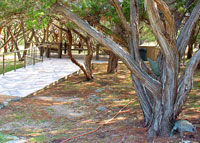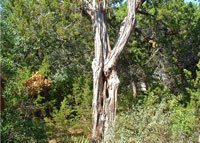Three Anti-environment Bills Fail to Pass
May 30, 2019
Three bills that would have harmed San Antonio's environment failed to win approval in the 86th Texas Legislature.
Campbell bill could have undermined tree ordinance
Although nobody testified in favor of Senate Bill 422, it was passed by the Senate and a House committee, but never made it to the House floor in time for a vote. In the last week of the session, Senator Campbell added SB 422, as an amendment, to another bill (HB 3750) which was intended to nullify certain Austin water quality protections.
HB 3750 was then sent back to the House with Campbell's amendment. When it came to the floor, a point-of-order, raised by Representative Erin Zwiener, killed the bill.
SB 422, as initially drafted, would have undermined 27,000 acres of San Antonio's tree preservation ordinance and given a huge taxpayer-funded windfall to developers.
Another Campbell bill would have led to massive clearcutting
After a contentious hearing, Senate Bill 2078 was left pending in a Senate committee. It would have nullified 410,000 acres of San Antonio's tree preservation ordinance and 46,000 acres of its aquifer protection ordinance.
Bill would have allowed destruction of endangered species habitat
House Bill 969 passed out of a House committee after a hearing where nobody testified in support. The cities of San Antonio and Austin cut a deal to drop opposition to the bill in exchange for retaining regulatory authority on commercial developments.
However, it was never referred to the House floor for a vote. It would have decimated endangered Golden-cheeked warbler habitat by allowing homebuilders to destroy old-growth Ashe juniper trees.
by Richard Alles, Forests/Trees conservation leaderCedar and Water — Conventional Wisdom Wrong
Numerous articles over many years have claimed that cedar (Ashe juniper) is a waterhogging plant that is depriving springs and streams of water and that its removal would provide large quantities of extra water. A new study appearing this spring has shown that, contrary to longstanding belief, increases in Edwards Plateau tree and shrubs over time have resulted in more—not less—water in regional streams.
The analysis of decades of stream flow data by Bradford Wilcox and Yun Huang of Texas A&M University showed that base flows in the Nueces, Frio, Guadalupe, and Llano rivers have significantly increased since the 1950s. Prior to the 1950s, base flows were about half what they have been since 1960. Total flow, which also includes storm flow from rainfall events, has increased in 3 of the 4 basins.
High numbers of sheep, cattle, horses, and goats on the land prior to 1960 (leading to overgrazing and overbrowsing) resulted in degraded watershed conditions. The bare land did not facilitate water infiltration, and the reduced groundwater was reflected in lower amounts of base flow in the streams. Reductions in the numbers of livestock in recent decades have allowed the vegetation of the watersheds to recover.
At the same time, numbers of trees (particularly cedar) have greatly increased. Thus, the vegetation recovered while becoming dominated by cedar. This vegetation recovery is responsible for approximately doubling the amount of base flow, because average rainfall has not increased during the period of study. Trees encourage water to infiltrate, and cedar is apparently beneficial in terms of increasing the amount of available water.
The study appears in Geophysical Research Letters.
Myths and facts about cedar
The tree known to most Hill Country residents as cedar, to range managers as Ashe juniper, and to botanists as Juniperus ashei has engendered a variety of opinions, but the facts about it are often overlooked. These facts about cedar are perhaps less colorful than the opinions, but should be put on the table for consideration by folks who want to understand the ecology of the place where they live and play. All too often, tales about cedar serve more to entertain listeners or confirm irrational beliefs than to enlighten. Here are ten common myths about cedar and the contrasting facts.
Myth: Cedar is a newcomer to the Hill Country.

Fact: Cedar is not an exotic species (Hatchet at. 1990: 20). It has been in the Hill Country for at least 19,600 years and perhaps much longer. Ancient pollen from Friesenhahn Cave in northern Bexar County provides the evidence (Hall and Valastro 1995: 239. 241). The tree has increased in abundance in some areas due to lack of natural and man-caused fires. It will also begin growing on sites where grasses have been removed by heavy grazing. However, old growth cedar is now uncommon or rare due to excessive cutting and clearing (Pulich 1976: 71, 161; Diamond et at. 1995: 191).
Myth: Cedar was imported from East Texas by birds.
Fact: Cedar (Ashe juniper) does not occur in East Texas. Eastern red cedar (Juniperus virginiana) is the only kind of cedar or juniper there, and it is not found in the Hill Country (Simpson 1988: 180, 188)
Myth: There was very little cedar before the white man arrived.
Fact: Extensive stands of cedar in the Hill Country have been documented by Spanish and American explorers in their writings (Weniger 1984). The amount of cedar woodlands when the area was settled by Europeans is not known with certainty, but seems to have been at least I million acres and perhaps several times that (Hall 1952: 12; Balthis 1934: 12): the matter is still open for scientific study and debate. What is certain is that the original vegetation of the Hill Country was not all savanna/grassland. It was instead about half woodland/forest and about half savanna/grassland (Weniger 1988: 18-19).
Myth: Cedar is not natural habitat for any animal.
Fact: The stringy bark of old cedar is required as nest-building material by the golden cheeked warbler, a bird that breeds only in the Hill Country and similar parts of Central Texas (Pulich 1976: 1. 10: Dunn and Garrett 1997: 291, 293). Biologists believe that the bird evolved in the area; it is in danger of extinction due largely to excessive clearing of old cedar. Cedar brakes also provide good cover for other wildlife, especially in winter. Removal of more than 70% of the cedar will result in fewer deer using an area (Rollins et al. 1988). Resident and migratory game and non-game birds, as well as many mammals besides deer, rely on cedar for cover during colder temperatures. The female plant offers valuable winter berries as a food source, too (Martin et al, 1951: 294-295)
Myth: Cedar causes erosion.
Fact: Cedar brakes protect watersheds from erosion much better than the poor grass cover typical of overgrazed Hill Country ranches (Nelle 1997: 5). Removing cedar may result in average soil losses of 11-12 tons per acre per year (Marsh and Marsh 1992: 4).
Myth: Cedar competes with other trees for water, eventually killing them.

Fact: There appears to be little or no evidence that cedar competitively replaces other trees. Yes, the tree is increasing in relative abundance due to lack of fire and perhaps livestock foraging (Smeins and Merrill 1988: 110; Owens 1996: 622). In addition, oak wilt, a fungal disease, may be contributing to a decrease in oak abundance. However, mixed cedar-oak and oak-cedar woodlands and forests are common in the Hill Country. Pure stands of cedar, which one would expect if they were driving out all other trees, are relatively uncommon.
Myth: A full-grown cedar tree will suck up 80 to 150 gallons of water a day.
Fact: A mature cedar will use about 33 gallons of water per day. A live oak of comparable size will use about 19 gallons per day (Owens 1996: 621).
Myth: Clearing cedar will provide lots of extra water for recharging the Edwards Aquifer.
Fact: While moderate amounts of clearing in small watersheds can increase the flows of minor springs in those places, it is very doubtful that this will translate into large quantities of water going into the Edwards Aquifer. That would require clearing almost all trees, including oaks, from the Hill Country, and would still not be effective unless the grasses that replaced the cedars and oaks were heavily grazed (White 2000: 7-8). In other words, only a barren Hill Country resembling a parking lot would provide large amounts of runoff to the Edwards Aquifer (White 2000: 1). It would be far better to keep the trees and simply use less water.
Myth: Cedar poisons other plants with its alleopathic chemicals.
Fact: Cedar is not an allelopath. Other plants are less common beneath cedar due to the heavy shade, accumulation of duff (dead foliage), and perhaps competition for water and nutrients (Smeins and Fuhlendorf 1997: 43; Lyons et al. nd.: 3). Trimming the lower branches of cedar allows light to reach the ground, increasing grass growth.
Myth: Cedar pollen is toxic, even deadly.
Fact: Cedar pollen is an allergen, but not toxic (Cox and Leslie 1988: 31).
To conclude, cedar is a native tree, well adapted to the limestone canyons and hills of the Edwards Plateau. Cedar’s main enemy, fire, has apparently decreased following the displacement of Native Americans. Overgrazing of grassy areas by livestock provided bare soil that could be colonized by cedar, a plant that does quite well on barren sites and provides erosion protection. Early German-Anglo settlers valued cedar as a source of fence posts, charcoal, poles, railroad ties, construction timbers and other wood products. Ranchers dislike cedar because it competes for space with grasses, perhaps explaining some of the myths surrounding it (more on these myths can be found in an article by Dean Keddy-Hector 2000).
References
- Baithis, R. F. 1934. Forestry lessons for students in vocational agriculture in Texas. Texas Forest Service Bulletin (24): 1-47.
- Cearley, J. and D. Rollins (eds.). 2000. Brush, water and wildlife: a compendium of our knowledge. Texas Agricultural Research & Extension Center, San Angelo. 111 pp.
- Cox. P. W. and P. Leslie. 1988. Texas trees: a friendly guide. Corona Publishing. San Antonio. 374 pp.
- Diamond, D. D., G. A. Roweli, and D. P. Keddy-Hector. 1995. Conservation of Ashe juniper (Juniperus ashei Buchholz) woodlands of the Central Texas Hill Country. Natural Areas Journal 15(2): 189-197.
- Dunn, J. L. and K. L. Garrett. 1997. A field guide to warblers of North America. Houghton Muffin, Boston, 656 pp.
- Hall, M. T. 1952. Variation and hybridization in Juniperus. Annals of the Missouri Botanical Garden 39(1): 1-64.
- Hall, S. A. and S. Valastro Jr. 1995. Grassland vegetation in the southern Great Plains during the last glacial maximum. Quaternary Research 44: 237-245.
- Hatch, S. L., K. N. Gandhi, and L. F. Brown. 1990. Checklist of the vascular plants of Texas. Texas Agricultural Experiment Station, College Station. 158 pp.
- Keddy-Hector, D. 2000. Myths of convenience and the role of the golden-cheeked warbler in Central Texas forest restoration. Wild Earth 10(3): 78-85.
- Lyons, R. K., Iv K, Owens, and R. V. Machen. no date. juniper biology and management in Texas. Texas Agricultural Extension Service, College Station. S pp.
- Marsh, W. M. and N. L. Marsh. 1992. juniper trees, soil loss, and local runoff processes. pp. 4-1 to 4-14 in C. I Woodruff, Jr., W. M. Marsh, and L. P. Wilding (eds.), Soils. Iandforms, hydrologic processes, and land-use issues Rose limestone terrains; Barton Creek watershed, Travis Couniy, Texas. Society of Independent Professional Earth Scientists, Central Texas Chapter, Austin.
- Martin, A. C., H. S. Zim and A. L. Nelson. 1951. American wildlife and plants. McGraw-Hill, New York. 500 pp.
Fred Wills, Species Conservation Contact